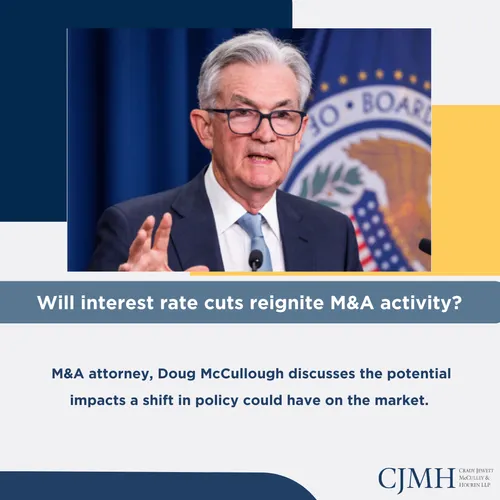
On Friday, Federal Reserve Chair Jerome Powell signaled that interest-rate cuts are likely forthcoming. Declaring that “The time has come for policy to adjust,” the Fed Chair seemed to indicate that the Fed’s priority would shift from fighting inflation to supporting a cooling job market.
The news of an imminent rate cut comes on the heels of a KPMG study that indicated that over half (60%) of 50 deal professionals at PE funds responded to a study that they expect to be engaged in at least one major transaction in the coming year – something CFO magazine described as a “surge.” Predictions of M&A surges have been made many times over the last 2 or more years. Will this time be different? Perhaps.
One of the greatest drags on the M&A market in recent years has been high interest rates. While large corporations may use publicly traded stock as consideration in M&A deals, private equity firms use a considerable amount of debt when acquiring target companies. As a result, PE deal activity has waned in the recent high interest-rate environment.
Powell’s indication that “the time has come for policy to adjust” signals a potential shift in the Fed’s focus from inflation control to supporting the job market. This change in priority could have far-reaching effects on the M&A landscape:
- Increased Deal Flow: Lower interest rates typically lead to more accessible and affordable debt financing, which is crucial for PE firms in structuring leveraged buyouts. The anticipated rate cuts could unlock the substantial dry powder currently sitting on the sidelines, potentially catalyzing a surge in M&A activity. Fast Fact: Private equity dry powder reached a record high of $2.59 trillion in 20231. This substantial amount of uninvested capital indicates that PE firms have ample resources to deploy once market conditions become more favorable, potentially leading to increased M&A activity following interest rate cuts.
- Improved Deal Valuations: As borrowing costs decrease, the overall cost of capital for acquirers is reduced. This can lead to higher valuations for target companies, potentially making sellers more willing to engage in M&A transactions. Fast Fact: The average debt-to-EBITDA ratio for leveraged buyouts (LBOs) in the U.S. decreased to 5.4x in 2023, down from 6.2x in 20222. This reduction in leverage suggests that PE firms have been more cautious in their deal structures due to high interest rates, and a rate cut could encourage them to pursue more aggressive acquisitions.
While the prospect of rate cuts is encouraging for the M&A market, it’s important to note that economic and political uncertainties still persist. The reduced leverage ratios observed in recent LBOs indicate that PE firms have adopted a more cautious approach. However, the combination of accumulated dry powder and potentially lower borrowing costs could create a more conducive environment for deal-making.
As the Fed prepares to adjust its monetary policy, the M&A market, particularly in the private equity sector, appears poised for a potential resurgence. The coming months will reveal whether this shift in interest rate policy will indeed be the catalyst needed to reignite M&A activity after a period of relative stagnation.
1 Source: S&P Global
2 Source: Pitch Book
Doug McCullough, Partner
